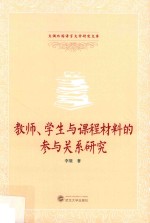

教师、学生与课程材料的参与关系研究PDF格式文档图书下载
- 购买点数:10 点
- 作 者:李展著
- 出 版 社:武汉:武汉大学出版社
- 出版年份:2018
- ISBN:9787307206441
- 标注页数:208 页
- PDF页数:225 页
Chapter One Introduction 1
1.1 Motivation for the Study 1
1.2 Background of the Study 4
1.3 Aims of the Study and Research Questions 6
1.4 Structure of the Book 8
Chapter Two Teachers’Enactment of Curriculum Materials:A Participatory Perspective 9
2.1 Defining Key Concepts in the Study 9
2.1.1 Curriculum Materials vs.Materials 9
2.1.2 Curriculum Materials Use vs.Materials Development 11
2.2 The Role of English Language Textbooks in the Global Context 12
2.3 CE Curriculum and Textbooks in Mainland China 14
2.3.1 The Evolution of CE Curriculum 14
2.3.2 Five Generations of CE Textbooks 17
2.4 Research on the Teacher-Curriculum Relationship in ELT 20
2.4.1 Teachers’Adaptation of Materials 20
2.4.2 Teachers’Use of Materials in ELT 21
2.5 Research on the Teacher-Curriculum Relationship in Mainstream Education 24
2.5.1 The Educative Role of Curriculum Materials and Teacher Learning 27
2.5.2 Teachers’Factors Influencing Their Use of Curriculum Materials 29
2.6 The Theoretical Framework of the Study 29
2.6.1 Theoretical Perspectives on Curriculum Use 29
2.6.2 The Theoretical Perspective of This Study 30
2.6.3 The Theoretical Framework of This Study 32
2.7 Summary 34
Chapter Three Methodology 35
3.1 Qualitative Multi-Case Study 35
3.2 Selection of Setting,Participants and Materials 37
3.2.1 The Target University 38
3.2.2 Participants 39
3.2.3 Target Textbook 41
3.3 Data Collection 45
3.3.1 Data Collection Schedule 46
3.3.2 Data Collection Strategies 48
3.4 Data Analysis 55
3.4.1 Analysis of Interview Data 56
3.4.2 Analysis of Observational Data 57
3.4.3 Documentary Analysis 59
3.5 Trustworthiness 59
3.5.1 Triangulation 60
3.5.2 Thick Description 60
3.5.3 Member Checking 61
3.5.4 Management of Subjectivity 61
3.5.5 Ethical Considerations in Data Collection 62
3.6 Summary 63
Chapter Four Teachers’Use of and Interactions with the Curriculum Materials 64
4.1 Scope of the Chapter 64
4.2 Features of Teachers’Interactions with the Curriculum Materials 64
4.3 Map of Teachers’Interactions with the Curriculum Materials 66
4.4 Reading 67
4.4.1 Reading the Students’Book 67
4.4.2 Reading the Teachers’Book 74
4.5 Evaluating 82
4.6 Appropriating and Adapting 85
4.6.1 Adjusting 85
4.6.2 Replacing 87
4.6.3 Supplementing 89
4.6.4 Omitting 91
4.6.5 Revising 92
4.6.6 Inventing 93
4.7 Understanding Teachers’Actions 96
4.7.1 The Meaning of the Teachers’Reading Process 96
4.7.2 The Meaning of the Teachers’Evaluation Process 99
4.7.3 The Meaning of Teachers’Appropriating and Adapting Processes 100
4.8 Summary 103
Chapter Five Influences on Teachers’Interactions with the Curriculum Materials 105
5.1 Overview of the Influential Factors of Teacher-Text Interactions 105
5.2 Contextual Factors Affecting Teacher-Text Interactions 106
5.2.1 Aspects of the Local Cultures 106
5.2.2 Support for Teachers with Regard to Curriculum Material Use 108
5.2.3 Inflexibility of the CE Curriculum 112
5.3 Features of the Curriculum Materials 114
5.4 Teachers’Personal Resources 120
5.4.1 Teachers’Beliefs 120
5.4.2 Teachers’Management of Curriculum Materials 123
5.4.3 Teachers’Knowledge 124
5.4.4 Teachers’Curricular and Pedagogical Goals 128
5.5 Student Voice 130
5.6 Summary 136
Chapter Six Discussion 137
6.1 Findings of the Current Study 138
6.1.1 Responding to the First Research Question 138
6.1.2 Responding to the Second Research Question 139
6.2 Conceptualising the Enactment of Curriculum Materials 141
6.2.1 Theoretical Underpinnings of the Study 142
6.2.2 Theorising Curriculum Materials:Multi-Layered Affordances of Curriculum Materials 143
6.2.3 Formation of the Curriculum Instruments:From Artefacts to Instruments 146
6.2.4 Mediated Relations in Enacting Curriculum Materials 149
6.2.5 Teachers’Knowledge in Materials Use 154
6.3 Instrumentation:Curriculum Materials Shaping Curriculum Enactment 155
6.3.1 The Ostensible Authority of Curriculum Materials in ELT in the Chinese Context 156
6.3.2 The Educative Role of Curriculum Materials 158
6.4 Instrumentalisation:Teachers’Role in Shaping the Curriculum Materials 160
6.4.1 Conceptualising Teachers’Use of Curriculum Materials:Teachers’Cognitive Processes 160
6.4.2 Adaptation of Curriculum Materials 162
6.5 The Participatory Relations Among Teachers,Learners,Curriculum Materials and the Context 164
6.5.1 Teacher Voice 167
6.5.2 Student Voice 168
6.6 Revisiting the Theoretical Framework 169
6.7 Summary 172
Chapter Seven Conclusions and Implications 174
7.1 Summary of the Study 174
7.1.1 The Purpose and Methodology of the Study 174
7.1.2 Summary of the Findings 176
7.2 Significance of the Study 178
7.3 Implications 180
7.3.1 Theoretical Implications 180
7.3.2 Practical Implications 182
7.4 Limitations and Recommendations for Future Research 188
Appendix Ⅰ Baseline Teacher Interview Protocol 190
Appendix Ⅱ Pre- and Post-Observation Teacher Interviews 193
Appendix Ⅲ Baseline Student Interview Protocol 194
Appendix Ⅳ Observation Analysis 195
References 196
- 《教师、学生与课程材料的参与关系研究》李展著 2018
- 《革新的课程实践者 教师参与课程变革研究》杨明全著 2003
- 《如何设计教师培训课程 参与式课程开发指南》(英)彼得·泰勒(Peter Taylor)著;陈则航译 2006
- 《中学语文参与式教师培训教程》靳健主编 2003
- 《小学语文参与式教师培训教程》靳健主编 2003
- 《小学数学参与式教师培训教程》吕世虎,肖鸿民编著 2003
- 《中学数学参与式教师培训教程》吕世虎,张定强编著 2003
- 《基于学生研究的课程与教学丛书 学生课程参与论》刘宇著 2012
- 《参与式语文学习活动设计 新课程 新教法 新学法》靳健,石义堂主编;教育部西北师范大学基础教育课程研究中心编 2002
- 《参与式数学教学 参训教师用书》刘杰,李惠萍主编 2010
- 《湖北文学专题论稿》李展著 2015
- 《黄鹂声声带血鸣 孙犁抗日小说研究》李展著 2009
- 《教师、学生与课程材料的参与关系研究》李展著 2018
- 《拾贝怀珍》张凯娴,李展辉主编 1999
- 《数码摄影圣经Ⅱ》(英)汤姆·安著;刘清扬,李展译 2013
- 《工业企业统计学》李展一 俞文华主编 1991
- 《绿染南粤》林洪主编;马恩成,张难生,蔡东士,李展副主编 1990
- 《在世界边缘遇见澳门》李展鹏著;廖子馨责任编辑 2013
- 《新闻写作》吴良勤,李展编著 2010
- 《统计学原理》李展一主编 1992
- 《出版探索 纪念武汉大学编辑出版学专业创建廿周年校友论文集》罗紫初,方卿主编 2003
- 《莎士比亚新论 武汉国际莎学研讨会论文集》阮珅主编 1994
- 《武汉会战》薛岳,赵子立等著 2015
- 《武汉会战亲历记》全国政协文史和学习委员会编 2015
- 《《科学》中的理化地生 武汉版 九年级 下》《科学》课研究组编 2006
- 《《科学》中的理化地生 武汉版 八年级 下》《科学》课研究组编 2006
- 《《科学》中的理化地生 武汉版 七年级 下》《科学》课研究组编 2006
- 《数字时代出版产业发展研究》黄先蓉,罗紫初主编 2007
- 《科学中的理化地生 九年级 上 武汉版》《科学》课研究组编 2006
- 《科学中的理化地生 七年级 上 武汉版》《科学》课研究组编 2006
